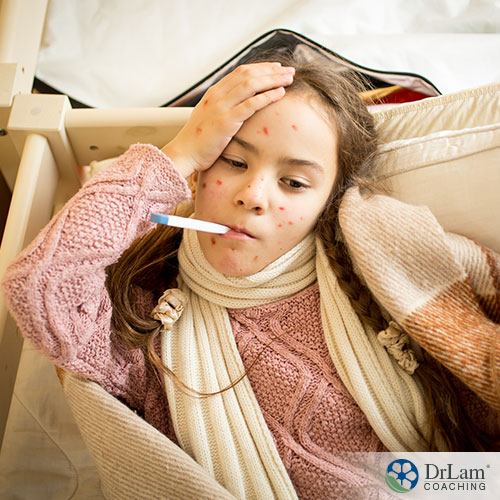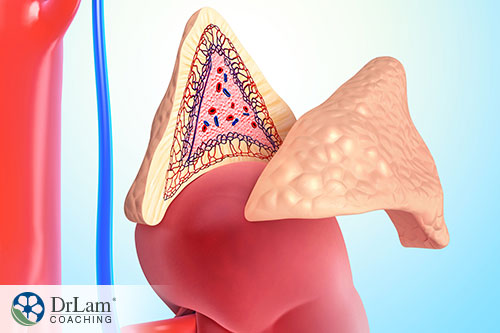PANS/PANDAS are two pediatric conditions that have a rapid onset. Not many parents know about them, and so when their children begin to exhibit the disturbing changes in behavior and mood, they are understandably distraught. PANS (pediatric acute-onset neuropsychiatric syndrome) is actually the broader condition while PANDAS (pediatric acute-onset neuropsychiatric disorder associated with streptococcal infection) is a specific form of PANS.
 As you may be able to tell from the name, PANDAS is triggered by a streptococcus infection. But PANS can come from any number of infections, including but not limited to:
As you may be able to tell from the name, PANDAS is triggered by a streptococcus infection. But PANS can come from any number of infections, including but not limited to:
Both the subset PANDAS and the general PANS conditions have neuropsychiatric symptoms, usually with a motor component. And these symptoms can come up so suddenly, that you feel as though your child is a totally different person.
Some of these neuropsychiatric symptoms include:
These symptoms may cause problems at school, with friends, or in general social contexts. PANS/PANDAS can affect children from age 3 years old all the way to puberty.
We are all exposed to microbes all the time. In fact, we have millions of them living on our skin and in our gut. Children are usually even more exposed to microbes due to the fact that they interact with other infected children a lot. In general, it’s actually a good thing that they are exposed to pathogens so that their immune systems get enough practice to become strong and responsive.
There are some cases, however, where the pathogens can create what we call “stealth infections.” These infections are not so easily detectable by the immune system. They can hide through a form of disguise. They put certain molecules on the outside of their cell walls, and these molecules are very similar to the molecules of the child’s own tissues and cells.
This buys the pathogens time to replicate and invade more and more parts of the body. And by the time the immune system detects their presence, they have already multiplied to overwhelming quantities. Not only that, but because they have these mimicking molecules as a defense, the immune system gets confused and starts attacking the healthy tissues that resemble them. This is the beginning of autoimmunity.
Unfortunately, many of these healthy tissues are in the central and peripheral nervous systems. And the reason that there are so many motor symptoms is because these autoimmune reactions tend to target the basal ganglia in the brain. The basal ganglia are a group of subcortical structures that are involved in motor control as well as motor learning, emotional behaviors, and other important functions.
Part of the immune response is to create inflammation. Inflammation is actually a natural and necessary part of protecting the body from the harmful insult, as well as getting rid of any dead or damaged cells.
Your child’s body, like everyone’s, is built to withstand acute inflammation once in a while. In fact, a weak inflammatory response can indicate a generally weak immune system. But if the inflammation gets out of hand, it can be very dangerous. And as it spreads to different parts of the body, it can cause issues there.
In the case of PANS/PANDAS, because the immune system was not able to detect and eliminate the infections quickly and the invading pathogens spread and replicated so much, the inflammatory response becomes much bigger. The inflammatory response is also much longer since the pathogens never left the body. And, on top of it, since the immune system is now attacking the body tissues as well, the inflammation is all over the place.
When the inflammation spreads to the brain and nervous system, you see even more of these neuropsychiatric symptoms. But you may also see inflammation spread to the gastrointestinal (GI) tract, causing digestive issues. Or to the skin, causing skin problems. Or to the musculoskeletal system, causing aches and pains. These are just a few possibilities. And they are all big stressors on the body.
All three of these - the invasion by the pathogen, the immune response, and the spread of inflammation - are a form of stress. And the body’s defense against stress comes in the form of the NeuroEndoMetabolic (NEM) Stress Response. Your NEM is composed of six circuits of organs and systems that work together to fight the stressor. These circuits are the Hormone, Bioenergetics, Cardionomic, Neuroaffect, Inflammation, and Detoxification circuits.
Although all the circuits are engaged when your body is fighting an infection, the ones that are most involved are the Inflammation circuit as well as the adrenal glands from the Hormone circuit. In the case of PANS/PANDAS, the Neuroaffect circuit is also affected as the autoimmune reaction targets the brain and nervous system, causing problems there.
 The adrenal glands are the NEM’s first line of defense against stress. They produce the body’s most important stress fighter, cortisol. They can dysregulate, however, if the stress turns chronic. That is because they have to overwork to produce enough cortisol on a continuous basis. This can lead to Adrenal Fatigue Syndrome (AFS).
The adrenal glands are the NEM’s first line of defense against stress. They produce the body’s most important stress fighter, cortisol. They can dysregulate, however, if the stress turns chronic. That is because they have to overwork to produce enough cortisol on a continuous basis. This can lead to Adrenal Fatigue Syndrome (AFS).
Symptoms of AFS include fatigue, insomnia, weight gain, brain fog, anxiety, mild depression, hair loss, dry skin, issues with sex hormone balance, hypoglycemia, salt and sugar cravings, food and drug sensitivities, lowered immunity, frequent or recurring infections, and heart palpitations, among others.
There is a misconception that only adults can get AFS, but children can also get it because they can get chronic stress. Recurring or stealth infections are the stressor that children with PANS/PANDAS are facing, and that can lead to them having AFS. And, as you can see, there are a few shared symptoms between the AFS and PANS and PANDAS.
With PANS/PANDAS, the adrenals are engaged quite early on, and right along with them is the Inflammation circuit. This circuit is composed of the immune system, the gut, and the microbiome. The microbiome is the collection of flora in the gut. And there can be many reasons the microbiome is not in balance. This condition is called dysbiosis.
Babies’ microbiomes are developed early on through being exposed to mom’s bacteria in the birth canal, and then getting some healthy microbes in breastmilk. But not all children are born vaginally nor are breastfed. Some children also have the compounded problem of frequent antibiotic use as they grow up.
A dysbiotic microbiome will lead to a weaker immune system. This is because about a third of the immune system cells are in the gut. They are called Gut-Associated Lymphoid Tissue (GALT), and they are crucial to a healthy immune response. Add to that the unhealthy diet many children are eating, full of junk food, processed food, sugar, and sodas, and you have a pretty potent combination of risk factors.
Not to mention the fact that around 15% of children in the US are on some kind of prescription medication for three or more months. This means that these children have a condition, such as ADHD, for which they are on some kind of medication. And medications have their own set of side-effects, especially on gut health.
 Although the adrenals and the Inflammation circuit are the two most important NEM components when talking about PANS/PANDAS, two others are closely linked: the Detoxification circuit and the Neuroaffect circuit.
Although the adrenals and the Inflammation circuit are the two most important NEM components when talking about PANS/PANDAS, two others are closely linked: the Detoxification circuit and the Neuroaffect circuit.
The Detoxification circuit is composed of the immune system, interstitium, and, most importantly, the liver. To a lesser degree, it also includes the kidneys, lungs, and skin. Basically, any organ that facilitates the exit of toxins and metabolic byproducts from the body.
This circuit is essential for the Inflammation circuit to function properly. They work in tandem, with the Inflammation circuit attacking and neutralizing the harmful substances and any dead or damaged cells, and the Detoxification circuit breaking these down and moving them out of the body through sweat, urine, feces, etc.
Unfortunately, the Detoxification circuit can become congested and slow, either due to an overwhelming toxic load or due to damage to one of its important components. This leads to a build-up of toxins in the body, leading to such issues as increased sensitivities to food and drugs, as well as an increase in inflammation.
This is why one of the steps you can take to help your child recover from PANS/PANDAS is to put them on a gentle detoxification protocol. This will not only help get rid of the build-up of toxins, but it will also allow their Inflammation circuit to do its job by getting rid of the pathogens properly. But it’s important that you do not undertake this step without medical supervision, as too little or too much detoxification can backfire and worsen your child’s condition.
The Neuroaffect circuit is the circuit that creates neurological and psychiatric symptoms when it dysregulates. That’s because it is composed of the brain, the autonomic nervous system, and the microbiome.
You can probably now see the pattern: every circuit is connected to another circuit through a component. The Neuroaffect circuit is connected to the Inflammation circuit through the microbiome, emphasizing the importance of improving your child’s gut health as part of the recovery process.
 A dysregulated Neuroaffect Circuit can create problems with sleep, anxiety, depression, irritability, moodiness, and an inability to handle stress. And if you combine these issues, plus the autoimmune attack on the basal ganglia in the brain, plus the spreading inflammation to the brain and nervous system, you can see why your child’s symptoms are so intense and sudden.
A dysregulated Neuroaffect Circuit can create problems with sleep, anxiety, depression, irritability, moodiness, and an inability to handle stress. And if you combine these issues, plus the autoimmune attack on the basal ganglia in the brain, plus the spreading inflammation to the brain and nervous system, you can see why your child’s symptoms are so intense and sudden.
But, even though all of these issues combined can seem like a very daunting challenge to tackle, there are ways you can help your child through this.
Please do not attempt to do this recovery process without the guidance of an experienced health professional. And although you know your child better than anyone, and you are the person that wants the best for them, there are certain delicate steps in this process that most parents are not trained in. And even if you were medically trained, your close emotional involvement in the matter may not allow you to make the most objective decisions.
So that means the first, and most important step, before the actual recovery, is to find the right kind of support. An experienced health professional can then adjust the following steps to your child’s individual needs and conditions, and adapt these steps as your child's needs change over time.
With any condition caused by an external stressor, there is no way to really recover until that stressor is gone. So, if your child is consistently exposed to pathogens and toxins, their immune system and NEM will not catch the break they need to recover. If you’re unsure what your child is exposed to and where, your health professional can help with that.
Lab work is a possible way to figure out which microbe is responsible for the PANS. With PANDAS, we already know it’s streptococcus. But it’s not just the pathogen that’s the culprit here. All the different factors that created a weakened immune system are stressors to be eliminated. This ranges from diet to an emotionally stressful environment.
We realize that you may not be able to fix psychological stressors such as financial pressure or problems at school at the drop of a hat. But there are ways to help your child cope with that kind of stress constructively, whether it’s through the school counselor, learning communication techniques, going to group support programs, or other ways. Your health professional can help you figure this out too.
Now that you know which pathogen was the trigger for the PANS/PANDAS, it’s time to deal with it. Most conventional doctors will recommend antibiotics or antiviral medications at this point. But in our opinion, these can sometimes cause more harm than good. Especially in the long term. They may bring more immediate results, but your child’s overall health can become even more vulnerable afterward. We don’t suggest you eliminate the option completely, but it’s better to leave it as a last resort.
One form of therapy we recommend trying at this point is low-dose immunotherapy (LDI). It’s a form of immunotherapy that is based on the principles of homeopathy – namely that “like cures like” and the use of the minimum dose. The major aim of LDI is to reduce the immune system’s reactivity, to calm the immune system down so that it stops the autoimmune attack on the healthy cells and tissues.
With autoimmunity, the hyperactivity of the immune system results in the production of cytokines. Cytokines are what trigger inflammation. And the hyperactivity comes from the over-stimulation of the T-helper cells, which are what attack the perceived threat. What needs to happen is for these T-helper cells to go back down to a normal range, thereby decreasing the immune system’s activity as well as the presence of cytokines.
The low-dose principle of LDI is meant to make the immune system more, not less, tolerant of the antigens. So instead of it provoking the immune system into an even bigger response, it decreases the autoimmunity. At this point, it can still function and attack the pathogens, but without going into overdrive.
 Right now, your child is fighting off an infection and beginning the long process of recovery. They need a lot of rest and sleep to handle this period. So, for now, it’s best to reduce any kind of pressure to do schoolwork or the different activities they take part in.
Right now, your child is fighting off an infection and beginning the long process of recovery. They need a lot of rest and sleep to handle this period. So, for now, it’s best to reduce any kind of pressure to do schoolwork or the different activities they take part in.
Even if they don’t sleep, resting in bed is a good idea. And to maximize their sleep, try to help them practice some good sleep hygiene routines. These include keeping the room cool and dark, not using digital devices at least two hours before bed or avoiding blue light, having a light snack of nuts or protein before bed to reduce the likelihood of a hypoglycemic episode at night, and reducing any noise or distractions at night.
In order to support the immune system, your child’s gut and microbiome have to be in the best shape possible. This means you need to change their diet and fill in any nutritional gaps they have. They should be eating fresh, organic, whole-foods. They should also be avoiding any foods that can trigger allergies or sensitivities.
Remember, your child may not have had a particular sensitivity to start with, but they may have developed one due to the weakening of their system and the congestion in the Detoxification circuit. So, even if you don’t think your child has issues with gluten, it’s best to avoid it for now.
The adrenal fatigue diet is a really good diet to use here because it not only does all of the above, but it is also very supportive of adrenal health. And your child needs strong adrenals to deal with the stress of the PANS/PANDAS and the recovery process. It is an anti-inflammatory, nutrient-dense, low-glycemic index diet that will fuel their body and replenish their depleted nutrient and energy stores. It’s also exactly the kind of diet that can help rebalance their microbiome and seal any leaks in the gut.
This is where the skill and experience of your health professional will really show great results, for both adrenal fatigue recovery and the overall recovery process. There are different types of gentle nutrients that can really help boost your child’s health, as well as their immunity.
Different types of vitamins, minerals, adaptogens, herbs, enzymes, prohormones, and glandulars can be used together. The goal is two-fold: use a therapeutic dose to give a good push, then use a maintenance dose to keep the recovery process going. These supplements can be combined in different ways. They can include antioxidants and immune-boosting nutrients. Some herbs can also help with detoxification.
The most important thing here is not to overload your child with too many supplements, as that can put more pressure on their liver and Detoxification circuit or even cause paradoxical reactions, the opposite of what you want.
Just like all the other steps, the detox needs to be very gentle. Your child’s adrenals are already weak and they can’t deal with a heavy detox right now, which can lead to an adrenal crash. But at the same time, it’s important to get rid of any toxic build-up and to return the Detoxification circuit to healthy function.
Whatever detox your health professional advises, please know that it may at first cause detoxification symptoms, such as headaches and fatigue. But that’s very different than an adrenal crash. So use your judgment and don’t be afraid to ask questions and follow up whenever you’re unsure.
 PANS/PANDAS can be quite a shock. It can change your child’s wellbeing and behavior almost overnight. They’re rapid-onset conditions caused by the immune system’s overreaction to stealth infections of different kinds. They can also be aggravated by the development of AFS or NEM dysregulation.
PANS/PANDAS can be quite a shock. It can change your child’s wellbeing and behavior almost overnight. They’re rapid-onset conditions caused by the immune system’s overreaction to stealth infections of different kinds. They can also be aggravated by the development of AFS or NEM dysregulation.
But there are steps you can take to help your child recover. These include improving their diet and supplementation, allowing them to rest, trying LDI therapy, and doing a gentle detox. But none of these should be done without the guidance and supervision of an experienced health professional.
If you have questions about PANS/PANDAS and adrenal fatigue recovery, you can contact the Dr. Lam Coaching team. We can offer you a free** no-obligation phone consultation at +1 (626) 571-1234 where we will privately discuss your symptoms and what your options are. You can also send us a question through our Ask The Doctor system by clicking here.
PANS/PANDAS are very rapid onset conditions that can affect your child’s neuropsychiatric health. You might see a sudden shift in behavior, mood, and motor control. And it can be quite a shock. But there are things you can do about it.
